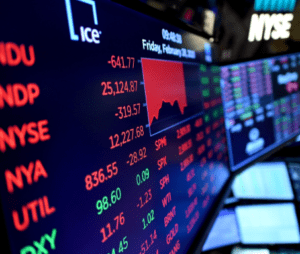Key Stock Market Terminology that You Need to Know
Looking to gain exposure to the world of stocks and shares, but somewhat confused by the never-ending jargon? While you don’t need to be an expert to invest in shares, it is important for you to have a firm understanding of key terms that you are likely to come across.
In this guide, we help clear the mist by discussing key stock market terminology in plain English. This covers everything from market orders, the spread, dividends, capital gains, and more.
-
-
Step 1: Getting Started
Rather than just publishing a long list of stock terms in alphabetical order – we think it is much more effective to break you in gently. As such, let’s start with the absolute basics.
What are Stocks and Shares?
In its most basic form, when a company is listed on a public exchange like the London Stock Exchange or New York Stock Exchange, it will issue a number of shares.
These shares are made available to the public, subsequently allowing everyday consumers to invest in the said firm. For each share that you hold, you will own a percentage of the company – proportionate to the amount you invest.
For example:
- Company ABC decides to issue 100,000 shares at £100 each
- This means that there are 100,000 shares in circulation
- You decide to buy 10 shares – taking your total investment to £1,000
- This means that you own 0.01% of the company
If you’re wondering what the difference is between stocks and shares, you might know that the two terms are used interchangeably. With that said, while stocks refer to the wider investment (i.e. “You own stocks in Apple”), shares refer to the number of individual holdings you have (“i.e. “You own 7 shares in Apple”).
IPO
In the above example, we noted that company ABC issued 100,000 shares at £100 each. This is known as an IPO – which stands for initial public offering. Once the IPO concludes, the firm will be listed on a stock exchange.
Market Capitalization
Additionally, it is also worth noting how the market capitalization (or ‘market cap’) of a company works. This is essentially the current market value of the company – and it takes into account:
- The total number of shares in circulation
- The current price of the shares
In the above example, we said that company ABC issues 100,000 shares at £100 each. This gives the company an initial market capitalization of £10 million. If its share price increased to £120, its market capitalization would now be worth £12 million.
Types of Shares
When companies issue stock, they can do so through a number of different share types. It is important for you to have an understanding of how each type differs, as it can determine what rights and conditions you as a shareholder have.
Ordinary shares
When you invest in shares through an online stock broker – it is all-but-certain that you will be buying ordinary shares. Put simply, you will be entitled to dividends as and when they are paid – at an amount proportionate to the number of ordinary shares you hold.
You will also have the remit to vote in shareholder AGMs (Annual General Meetings). If the company ran into financial problems and filed for bankruptcy, you would sit behind ‘preference’ shareholders when the remaining assets get distributed.
Preference shares
As the name suggests, preference shares give the holder ‘preference’ if the company was wound up. That is to say, any remaining assets left on the balance sheet would be used to settle what you are owed as a preference shareholder.
This particular share type also entitles the holder to a fixed dividend that takes preference over ordinary shareholders. However, the specific yield is typically much lower.
Non-Voting shares
Non-voting shares are typically issued to employees of the company. They entitle the holder to dividends – but as the name suggests, no right to vote.
Step 2: The Investment Process
The next set of key stock terminology that we need to discuss is related to the actual investment process.
Stock Brokers and Share Dealing Platforms
Yet another duo of terms that are often used interchangeably is that of stock brokers and share dealing platforms. For all intents and purposes, both provide the same service.
That is to say, stock brokers and share dealing platforms both allow you to buy shares online.
They require you to open an account and deposit funds, and then you will get to choose which shares you wish to purchase.
The platform in question will use its resources to obtain shares from the primary market, where it will have the capacity to meet a minimum lot size. In turn, the broker will then sell these shares to members of its platform.
Stock Price
The stock price of a company is simply the current market value of the shares. For example, if you invest £100 into Royal Mail and you received 80 shares – then the stock price is 125p (£100 / 80). However, as we discuss below, there will always be a ‘gap’ in stock prices when you make a purchase.
Bid and Ask Price
In its most basic form, the ‘bid’ price of a stock is what buyers want to pay for the shares. At the other end of the spectrum, the ‘ask’ price is what sellers are willing to accept for the shares they hold. For example, if a buyer wants to purchase Facebook shares at $250, this is the bid price. If sellers demand $251, then this is the ask price.
The Spread
Leading on from the above section, the spread is the difference between the bid and ask price of a stock. If the bid and ask is $250 and $251 respectively, then this gap in pricing amounts to 0.4%. The wider the spread, the more you indirectly pay in fees. This is because you need to make gains equal to the spread just to break even.
Orders
When you invest in stocks, you will need to place an order with your chosen stock broker. There are several orders in particular that you need to be made aware of – such as:
- Market Order: If you place a ‘market’ order, this means that you will get the next available price of your chosen shares. For example, although BP shares might be priced at 315p when you load up the order, the stock price will change on a second-by-second basis. As such, by placing a market order, you will likely pay a price slightly above or below 315p.
- Limit Order: A ‘limit order’ allows you to specify the price that your stock investment is executed at. For example, although Tesco shares are currently priced at 233p, you might not want to buy them until they go down to 225p. You limit order will only be matched if and when the stated price is matched by the markets.
- Stop-Loss Order: As the name suggests, a stop-loss order allows you to mitigate your losses. For example, let’s suppose that you buy Barclays shares at 100p. You decide that you want to limit your losses to 10%, so you set your stop-loss order at 90p. If the price of 90p is reached, the stop-loss order ensures that the shares are automatically sold.
- Take-Profit Order: This works largely the same as a stop-loss, but in reverse. Sticking with the same as example, you might decide that you want to sell your Barclays shares once you make a 20% profit – so you set your take-profit order to 120p.
Portfolio
A portfolio simply refers to a basket of share investments. For example, if you have investments in 20 different companies, your portfolio contains 20 different stocks. As such, when you attempt to calculate the value of your portfolio, you are simply adding up each and every stock investment that you have.
Diversification
Diversification is a form of risk mitigation. It simply means that you invest in lots of different companies from several sectors to ensure that you are not overexposed to a single firm.
For example, let’s say that you have £10,000 to invest in the stock markets. A well-diversified portfolio might consist of 100 different stock investment at £100 each. Furthermore, these 100 companies might come from 10 different sectors – such as retail, oil and gas, banking, technology, and travel.
Stock Exchange
A stock exchange is simply the platform that the company is listed on – subsequently allowing people to buy and sell its shares. In the UK, the primary exchange is that of the London Stock Exchange (LSE). You also have the Alternative Investment Market (AIM), which is a stock exchange for small-to-medium UK companies.
Outside of the UK, you have the New York Stock Exchange (NYSE) and the NASDAQ in the US, and then the Tokyo Stock Exchange (TSE) in Japan. With that said, you might be surprised to learn that virtually every country has a public stock exchange of some sort – it’s just that volume and liquidity is much lower than major exchanges found in the US, UK, and Japan.
Step 3: The Financials
So now that you know the key stock terminology found when buying shares online, we now need to dig a little deeper by looking at the financials.
Capital Gains
Regardless of the asset class that you are investing in, capital gains simply refers to the amount of profit you make when you sell the asset for a higher price than you originally paid.
For example:
- You buy £2,000 worth of shares in HSBC
- You originally paid 350p per share
- A few years later, HSBC shares are worth 700p
- This means that your investment is now worth £4,000
- You sell your shares and your capital gains amount to £2,000 (£4,000 – £2,000)
There is, however, no guarantee that you will make capital gains when you invest in stocks as there is every chance the shares will go down in value.
Dividends
Dividends stocks are popular with investors as they allow you to make money in addition to capital gains. So, when companies make a profit, they will often share some of the proceeds with those holding stocks. For example, let’s suppose that Nike decides to pay a dividend of $4 per share. If you were to in possession of 10 shares, you would receive $40 in dividends. Not all companies pay dividends, but when they do the payment is often distributed every 3 or 6 months.
Yield
The term yield is somewhat of a broad one, as it can often refer to several outcomes – all of which centre on financial gain. More specifically, the yield is the amount of money that you make from an investment in percentage terms. For example, if you invest £1,000 into IBM shares and then 12 months later the shares are worth £1,200 – your yield is 20%. Similarly, if you have £500 worth of shares in BT and you received £50 in dividends, the yield is 10%.
Stock Splits
Stock splits are a crucial term to understand, as there is every chance that you will encounter one. Crucially, when the value of a stock increases for an indefinite period of time, the respective company might decide to ‘split’ its stocks. This means that it will issue more stocks and then distribute them to current shareholders.
For example:
- Let’s say that in 2020 you buy 10 shares in British American Tobacco when the stocks are worth £20
- In 2024, we’ll say that they are worth £60 per share
- In order to make their shares more affordable, British American Tobacco might do a 3-1 stock split
- In plain English, this means that for every 1 share you hold, you will now own 3
However, don’t be fooled into thinking that your stock portfolio is now worth 3 times more. On the contrary, as there are 3 times as many shares in circulation, this will be reflected in the stock price. As per the above, British American Shares were worth £60 before the stock split. After the stock split, they would have been worth £20, albeit, you have 30 shares now instead of 10!
Step 4: Advanced Terms
The final chapter of our guide on key stock market terminology will look at some advanced terms that you might come across.
Leverage
Leverage is a sophisticated tool that allows you to trade with more money than you have in your brokerage account. For example, if you stake £500 at leverage of 5x (or 1:5), you are essentially trading with £2,500.
In doing so, you are borrowing the surplus funds from the respective broker, meaning that you will be charged a rate of interest (known as ‘overnight financing’).
Take note, if leverage is something you do want to explore further, you will be trading stock CFDs as opposed to buying traditional equities.
This means that you will not own the underlying asset, as you will be speculating on the future value of the stock CFD – which merely tracks the real-world price of the shares.
Margin Trading
Margin trading, or ‘trading on margin’, is directly linked to leverage. In the example we gave above – you traded with £2,500 even though you only ‘staked’ £500. This £500 is known as your ‘margin’, which is somewhat like a security deposit. As £500 of £2,500 amounts to 20%, this is the amount of margin that the broker requires from you to facilitate the trade.
Margin Call
If you receive a ‘margin call’ from your chosen broker when applying leverage, this means that you are close to being ‘liquidated’. In simple terms, this means that your margin balance is about to go into negative territory, so the broker will need to close the position. As per the previous example, you will be liquidated if your investment went against you by more than 20% – as this is the amount of margin you put up.
Secondary Offering
If a company decides to initiate a secondary offering, this means that they are looking to raise additional capital. In doing so, the company will issue more shares. This isn’t a good thing – as it means the shares you currently hold will be ‘diluted’.
For example:
- Let’s say that the company has 1 million shares in circulation
- You hold 100 shares, with each share currently worth £10
- The company then initiates a secondary offering by issuing 1 million additional shares
- As there are twice the number of shares in circulation, the value of your shares has essentially been split in half
Bullish and Bearish
If a stock is performing well – meaning that its share price is increasing, the markets are ‘bullish’. This simply means that the general sentiment around the company is positive. At the other end of the spectrum, ‘bearish’ means the opposite. That is to say, market sentiment on the company is negative, meaning the shares are likely going down in value.
Going Long and Going Short
If you think that the value of an asset (such as stocks) is likely to go up, then you are ‘going long’. If you think that the asset will go down in value, you are ‘going short’. These particular terms are more congruent with stock CFD trading, as you always have the options of going long or short. When using a tradition stock broker to invest in shares, you can only go long.
The Verdict
In summary, getting involved in the stocks and shares space as a first-time buyer has never been easier. Once you have quickly opened a stock broker account and deposited funds with a UK payment method – you will then have access to thousands of shares at the click of a button.
However, it’s best to have a firm understanding of the many key stock terms that you are likely to come across. With that in mind, we hope this guide has helped clear the mist!
Kane Pepi
Kane Pepi is a British researcher and writer that specializes in finance, financial crime, and blockchain technology. Now based in Malta, Kane writes for a number of platforms in the online domain. In particular, Kane is skilled at explaining complex financial subjects in a user-friendly manner. Academically, Kane holds a Bachelor’s Degree in Finance, a Master’s Degree in Financial Crime, and he is currently engaged in a Doctorate Degree researching the money laundering threats of the blockchain economy. Kane is also behind peer-reviewed publications - which includes an in-depth study into the relationship between money laundering and UK bookmakers. You will also find Kane’s material at websites such as MoneyCheck, the Motley Fool, InsideBitcoins, Blockonomi, Learnbonds, and the Malta Association of Compliance Officers.
 In its most basic form, when a company is listed on a public exchange like the London Stock Exchange or New York Stock Exchange, it will issue a number of shares.
In its most basic form, when a company is listed on a public exchange like the London Stock Exchange or New York Stock Exchange, it will issue a number of shares. Yet another duo of terms that are often used interchangeably is that of
Yet another duo of terms that are often used interchangeably is that of  Leverage is a sophisticated tool that allows you to trade with more money than you have in your brokerage account. For example, if you stake £500 at leverage of 5x (or 1:5), you are essentially trading with £2,500.
Leverage is a sophisticated tool that allows you to trade with more money than you have in your brokerage account. For example, if you stake £500 at leverage of 5x (or 1:5), you are essentially trading with £2,500.